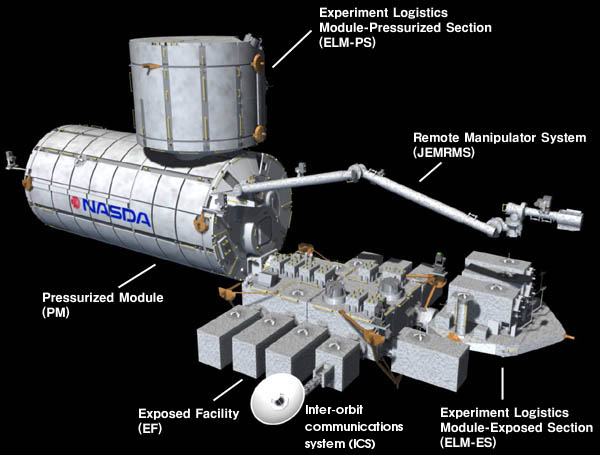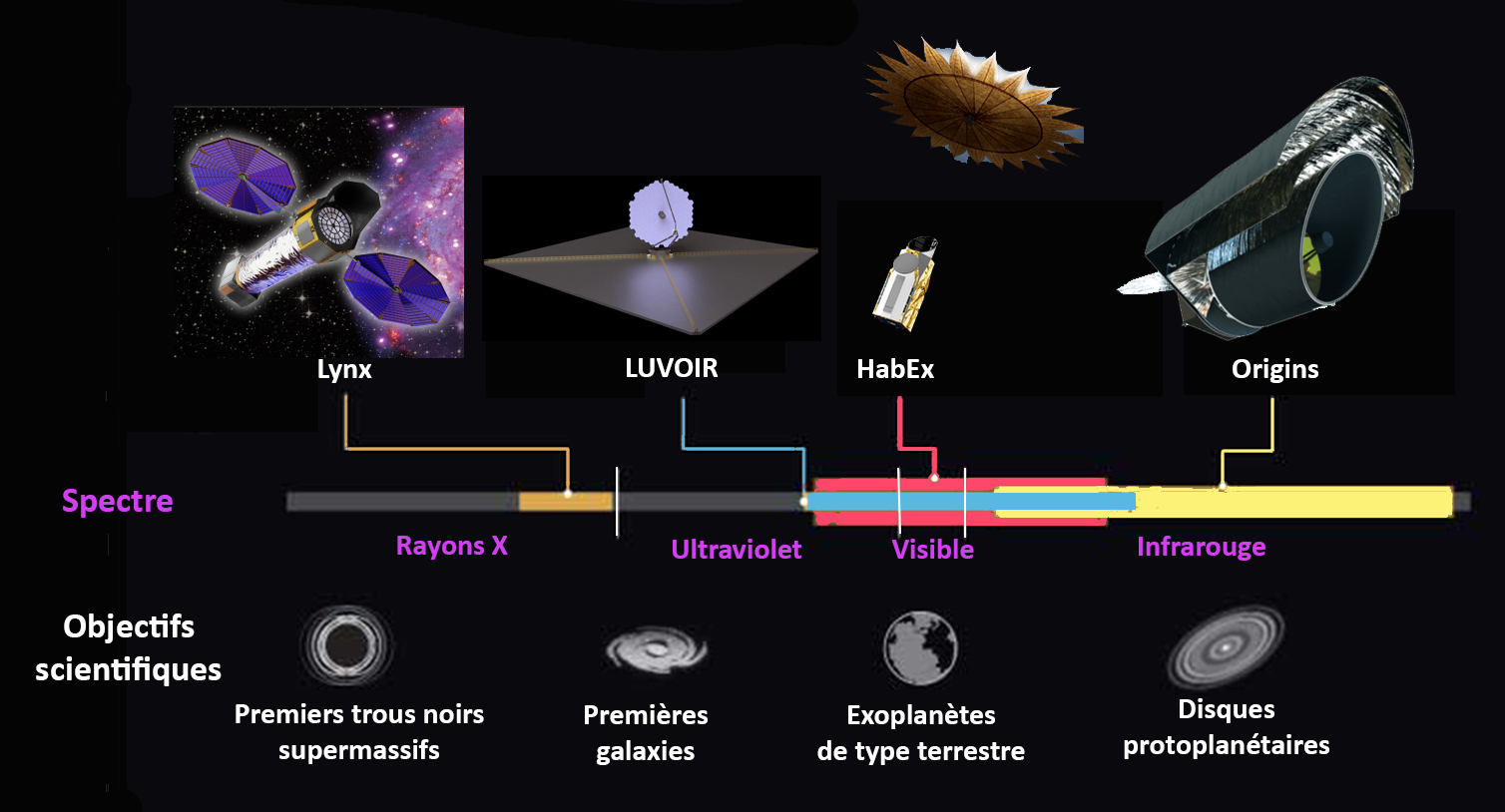|
List Of Proposed Space Observatories
This list contains proposals for space telescopes, space-based (situated in space) astronomical observatories. It is a list of past and present space observatory plans, concepts, and proposals. For observatories in orbit, see list of space telescopes. Unlike that list, this one includes concepts and proposals that are unlikely ever to be launched, as they may have been cancelled or were only proposals. Space observatories under development Merged, cancelled, or superseded space observatories Additional examples and non-space telescopes For launch in the 2030s, NASA is evaluating four possible designs: the Origins Space Telescope, Lynx X-ray Surveyor, Habitable Exoplanet Imaging Mission (HabEx), and Large UV Optical Infrared Surveyor ( LUVOIR). Balloon-borne telescopes have been in use since the 1950s. A 20–30 meter balloon telescope has been suggested. The balloon would be transparent on one side, and have a circular reflecting mirror on the other side. There are ... [...More Info...] [...Related Items...] OR: [Wikipedia] [Google] [Baidu] |
Space Telescopes
A space telescope or space observatory is a telescope in outer space used to observe astronomical objects. Suggested by Lyman Spitzer in 1946, the first operational telescopes were the American Orbiting Astronomical Observatory, OAO-2 launched in 1968, and the Soviet Orion 1 ultraviolet telescope aboard space station Salyut 1 in 1971. Space telescopes avoid the filtering and distortion ( scintillation) of electromagnetic radiation which they observe, and avoid light pollution which ground-based observatories encounter. They are divided into two types: Satellites which map the entire sky (astronomical survey), and satellites which focus on selected astronomical objects or parts of the sky and beyond. Space telescopes are distinct from Earth imaging satellites, which point toward Earth for satellite imaging, applied for weather analysis, espionage, and other types of information gathering. History Wilhelm Beer and Johann Heinrich Mädler in 1837 discussed the advantages of ... [...More Info...] [...Related Items...] OR: [Wikipedia] [Google] [Baidu] |
JAXA
The is the Japanese national air and space agency. Through the merger of three previously independent organizations, JAXA was formed on 1 October 2003. JAXA is responsible for research, technology development and launch of satellites into orbit, and is involved in many more advanced missions such as asteroid exploration and possible human exploration of the Moon. Its motto is ''One JAXA'' and its corporate slogan is ''Explore to Realize'' (formerly ''Reaching for the skies, exploring space''). History On 1 October 2003, three organizations were merged to form the new JAXA: Japan's Institute of Space and Astronautical Science (ISAS), the National Aerospace Laboratory of Japan (NAL), and National Space Development Agency of Japan (NASDA). JAXA was formed as an Independent Administrative Institution administered by the Ministry of Education, Culture, Sports, Science and Technology (MEXT) and the Ministry of Internal Affairs and Communications (MIC). Before the merger, ISA ... [...More Info...] [...Related Items...] OR: [Wikipedia] [Google] [Baidu] |
XEUS
XEUS (X-ray Evolving Universe Spectroscopy) was a space observatory plan developed by the European Space Agency (ESA) as a successor to the successful XMM-Newton X-ray satellite telescope. It was merged to the International X-ray Observatory (IXO) around 2008, but as that project ran into issues in 2011, the ESA component was forked off into Advanced Telescope for High Energy Astrophysics (Athena). XEUS consisted of a mirror spacecraft that carried a large X-ray telescope, with a mirror area of about 5 m² and an imaging resolution better than 5 in; for X-ray radiation with an energy of 1 keV. A detector spacecraft would have flown in formation with the telescope at a distance of approximately 50 m, in the focus of the telescope. The detectors would have included a wide-field X-ray imager with an energy resolution of 150 eV at 6 keV, as well as a cryogenic narrow-field imager with an energy resolution of 2 eV at 1 keV. XEUS would have been able to measure the X-ray spec ... [...More Info...] [...Related Items...] OR: [Wikipedia] [Google] [Baidu] |
Origins Space Telescope
Origins Space Telescope (Origins) is a concept study for a far-infrared survey space telescope mission.Preparing for the 2020 Decadal Survey Large Mission Concepts (PDF) , NASA A preliminary concept in pre-formulation, it was presented to the in 2019 ... [...More Info...] [...Related Items...] OR: [Wikipedia] [Google] [Baidu] |
Lynx X-ray Observatory
The Lynx X-ray Observatory (''Lynx'') is a NASA-funded Large Mission Concept Study commissioned as part of the National Academy of Sciences 2020 Astronomy and Astrophysics Decadal Survey. The concept study phase is complete as of August 2019, and the ''Lynx'' final report has been submitted to the Decadal Survey for prioritization. If launched, ''Lynx'' would be the most powerful X-ray astronomy observatory constructed to date, enabling order-of-magnitude advances in capability over the current Chandra X-ray Observatory and XMM-Newton space telescopes. Background In 2016, following recommendations laid out in the so-called Astrophysics Roadmap of 2013, NASA established four space telescope concept studies for future Large strategic science missions. In addition to ''Lynx'' (originally called X-ray Surveyor in thRoadmap document'','' they are the Habitable Exoplanet Imaging Mission (HabEx), the Large Ultraviolet Optical Infrared Surveyor (LUVOIR), and the Origins Space Te ... [...More Info...] [...Related Items...] OR: [Wikipedia] [Google] [Baidu] |
National Academies Of Sciences, Engineering, And Medicine
The National Academies of Sciences, Engineering, and Medicine (also known as NASEM or the National Academies) are the collective scientific national academy of the United States. The name is used interchangeably in two senses: (1) as an umbrella term for its three quasi-independent honorific member organizations the National Academy of Sciences (NAS), the National Academy of Engineering (NAE), and the National Academy of Medicine (NAM); and (2) as the brand for studies and reports issued by the operating arm of the three academies, the National Research Council (NRC). The NRC was first formed in 1916 as an activity of the NAS. Now jointly governed by all three academies, the NRC produces some 200 publications annually which are published by the National Academies Press. The reports produced by the National Academies have been characterized as reflective of scientific consensus. History The US National Academy of Sciences was created by an Act of Incorporation dated March 3, 18 ... [...More Info...] [...Related Items...] OR: [Wikipedia] [Google] [Baidu] |
Habitable Exoplanet Imaging Mission
The Habitable Exoplanet Observatory (HabEx) is a space telescope concept that would be optimized to search for and image Earth-size habitable exoplanets in the habitable zones of their stars, where liquid water can exist. HabEx would aim to understand how common terrestrial worlds beyond the Solar System may be and determine the range of their characteristics. It would be an optical, UV and infrared telescope that would also use spectrographs to study planetary atmospheres and eclipse starlight with either an internal coronagraph or an external starshade. The proposal, first made in 2016, is for a large strategic science missions NASA mission. It would operate at the Lagrange point L2. Overview In 2016, NASA began considering four different space telescopes as the next Flagship (Large strategic science missions). They are the Habitable Exoplanet Observatory (HabEx), Large Ultraviolet Optical Infrared Surveyor (LUVOIR), Origins Space Telescope, and Lynx X-ray Surveyor ... [...More Info...] [...Related Items...] OR: [Wikipedia] [Google] [Baidu] |
Large Ultraviolet Optical Infrared Surveyor
The Large Ultraviolet Optical Infrared Surveyor, commonly known as LUVOIR (), is a multi-wavelength space telescope concept being developed by NASA under the leadership of a Science and Technology Definition Team. It is one of four large astrophysics space mission concepts studied in preparation for the National Academy of Sciences 2020 Astronomy and Astrophysics Decadal Survey. While LUVOIR is a concept for a general-purpose observatory, it has the key science goal of characterizing a wide range of exoplanets, including those that might be habitable. An additional goal is to enable a broad range of astrophysics, from the reionization epoch, through galaxy formation and evolution, to star and planet formation. Powerful imaging and spectroscopy observations of Solar System bodies would also be possible. LUVOIR would be a Large Strategic Science Mission and was considered for a development start sometime in the 2020s. The LUVOIR Study Team, under Study Scientist Aki Roberge, ha ... [...More Info...] [...Related Items...] OR: [Wikipedia] [Google] [Baidu] |
Indian Space Research Organisation
The Indian Space Research Organisation (ISRO; ) is the national space agency of India, headquartered in Bengaluru. It operates under the Department of Space (DOS) which is directly overseen by the Prime Minister of India, while the Chairman of ISRO acts as the executive of DOS as well. ISRO is India's primary agency for performing tasks related to space-based applications, space exploration and the development of related technologies. It is one of six government space agencies in the world which possess full launch capabilities, deploy cryogenic engines, launch extraterrestrial missions and operate large fleets of artificial satellites. The Indian National Committee for Space Research (INCOSPAR) was established by Jawaharlal Nehru under the Department of Atomic Energy (DAE) in 1962, on the urging of scientist Vikram Sarabhai, recognising the need in space research. INCOSPAR grew and became ISRO in 1969, within DAE. In 1972, the government of India set up a Space Commissi ... [...More Info...] [...Related Items...] OR: [Wikipedia] [Google] [Baidu] |
Astronomical Unit
The astronomical unit (symbol: au, or or AU) is a unit of length, roughly the distance from Earth to the Sun and approximately equal to or 8.3 light-minutes. The actual distance from Earth to the Sun varies by about 3% as Earth orbits the Sun, from a maximum (aphelion) to a minimum (perihelion) and back again once each year. The astronomical unit was originally conceived as the average of Earth's aphelion and perihelion; however, since 2012 it has been defined as exactly (see below for several conversions). The astronomical unit is used primarily for measuring distances within the Solar System or around other stars. It is also a fundamental component in the definition of another unit of astronomical length, the parsec. History of symbol usage A variety of unit symbols and abbreviations have been in use for the astronomical unit. In a 1976 resolution, the International Astronomical Union (IAU) had used the symbol ''A'' to denote a length equal to the astronomical ... [...More Info...] [...Related Items...] OR: [Wikipedia] [Google] [Baidu] |
Earth-trailing Orbit
The Spitzer Space Telescope, formerly the Space Infrared Telescope Facility (SIRTF), was an infrared space telescope launched in 2003. Operations ended on 30 January 2020. Spitzer was the third space telescope dedicated to infrared astronomy, following IRAS (1983) and ISO (1995–1998). It was the first spacecraft to use an Earth-trailing orbit, later used by the Kepler planet-finder. The planned mission period was to be 2.5 years with a pre-launch expectation that the mission could extend to five or slightly more years until the onboard liquid helium supply was exhausted. This occurred on 15 May 2009. Without liquid helium to cool the telescope to the very low temperatures needed to operate, most of the instruments were no longer usable. However, the two shortest-wavelength modules of the IRAC camera continued to operate with the same sensitivity as before the helium was exhausted, and continued to be used into early 2020 in the Spitzer Warm Mission. During the warm mission, ... [...More Info...] [...Related Items...] OR: [Wikipedia] [Google] [Baidu] |









